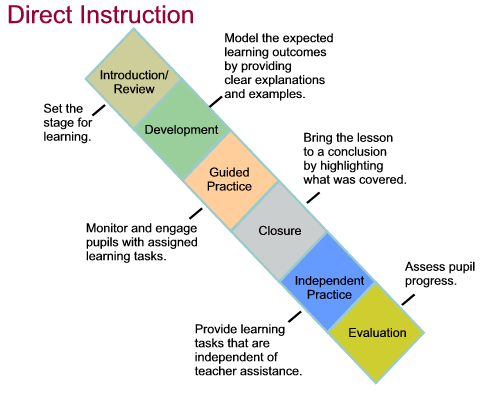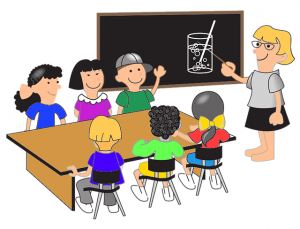This week I will be looking at the topic of direct instruction. Direct instruction can be outlined as a teacher working directly with a group of students rather than the students working on tasks without the teacher (Davis, 2018). This is modelled by teachers imparting their knowledge by ‘telling’ students information (Davis, 2018). Direct instruction is often associated with a traditional approach, visualized as students sitting in rows staring at a teacher. Characteristics of direct instruction described by Cook, Holland, and Slemrod begin with a teacher describing a skill and demonstrating it, followed by students participating in shared practice, and concluding with independent demonstration of the skill (2014). On the other hand, Flores and Ganz explain a more extreme version of direct instruction which includes the instructor following a given script, choral student responses, the use of a clear signal to instigate student responses, consequences for incorrect responses, and modelling skills (2009). Although these two definitions differ, the main takeaway of both is that the teacher executes the instruction and the students follow. Torgesen argues that explicit instruction does not leave anything to chance, ensuring that no prior assumptions are made about skills and knowledge that children will acquire on their own (2004). From a progressivist standpoint, direct instruction is a controversial instruction method to choose, as the idea of it being “old school” links behaviorist theory to the approach.

Direct instruction can be outlined as a teacher working directly with a group of students rather than the students working on tasks without the teacher (Davis, 2018). This is modelled by teachers imparting their knowledge by ‘telling’ students information (Davis, 2018). Direct instruction is often associated with a traditional approach, visualized as students sitting in rows staring at a teacher. Characteristics of direct instruction described by Cook, Holland, and Slemrod begin with a teacher describing a skill and demonstrating it, followed by students participating in shared practice, and concluding with independent demonstration of the skill (2014). On the other hand, Flores and Ganz explain a more extreme version of direct instruction which includes the instructor following a given script, choral student responses, the use of a clear signal to instigate student responses, consequences for incorrect responses, and modelling skills (2009). Although these two definitions differ, the main takeaway of both is that the teacher executes the instruction and the students follow. Torgesen argues that explicit instruction does not leave anything to chance, ensuring that no prior assumptions are made about skills and knowledge that children will acquire on their own (2004). From a progressivist standpoint, direct instruction is a controversial instruction method to choose, as the idea of it being “old school” links behaviorist theory to the approach.
My group’s Interactive Learning Resource on the topic of descriptive language focuses on the instructional method of cooperation. Although this is the main method of instruction, there are elements of direct instruction that can be seen based on our Blueprint. Students learn the definition of adjectives as well as examples through instruction from the teacher. Although students will be engaged in this process through being asked for their ideas and confirming their understanding, it is apparent that the teacher directly explaining what an adjective is would be identified as direct instruction. As well, the activities provided throughout the lesson will be explained by the teacher directly to the students. There is an opportunity for students to ask clarification questions, but the teacher is explaining the task as well as modeling to the students what this should look like. Although direct instruction is not the main focus of our resource, it is definitely apparent throughout, as we see it to be a valuable method for explaining complex topics to students. Personally, I do not love when direct instruction is the main element of a lesson, however I see the value in including it to explain specific concepts that students need to understand as a foundation for further learning. As Heidi mentioned in her post, with an example such as workplace hazards, direct instruction may be the best instructional method to choose due to others being dangerous. In the case of our resource, we believe it is better for students to have a clear understanding of what an adjective is, as well as gain a clear understanding of what is expected of them to complete. We believe direct instruction allows for the simplest and most coherent way to help students gain this knowledge. Once they have a basic understanding, they will be able to participate in other instructional methods that will help deepen their understanding, including cooperative and experiential learning. Due to direct instruction being apparent in our Blueprint, it will also be included in our final Interactive Learning Resource.
References:
Cook C, Holland E and Slemrod T (2014) Evidence-based reading decoding instruction. In: Little S and Akin-Little A (eds) Aca- demic Assessment and Intervention. London: Routledge, 199–218.
Davis, A. (2018). Evidence-based approaches to education. Management in Education,32(3), 135-138. doi:10.1177/0892020618765421
Flores M and Ganz J (2009) Effects of direct instruction on the reading comprehension of students with autism and develop- mental disabilities. Education and Training in Developmental Disabilities 44(1): 39–53.
Torgesen J (2004) Preventing early reading failure—and its devastating downward spiral. American Educator 28(3): 6–19.

Leave a Reply